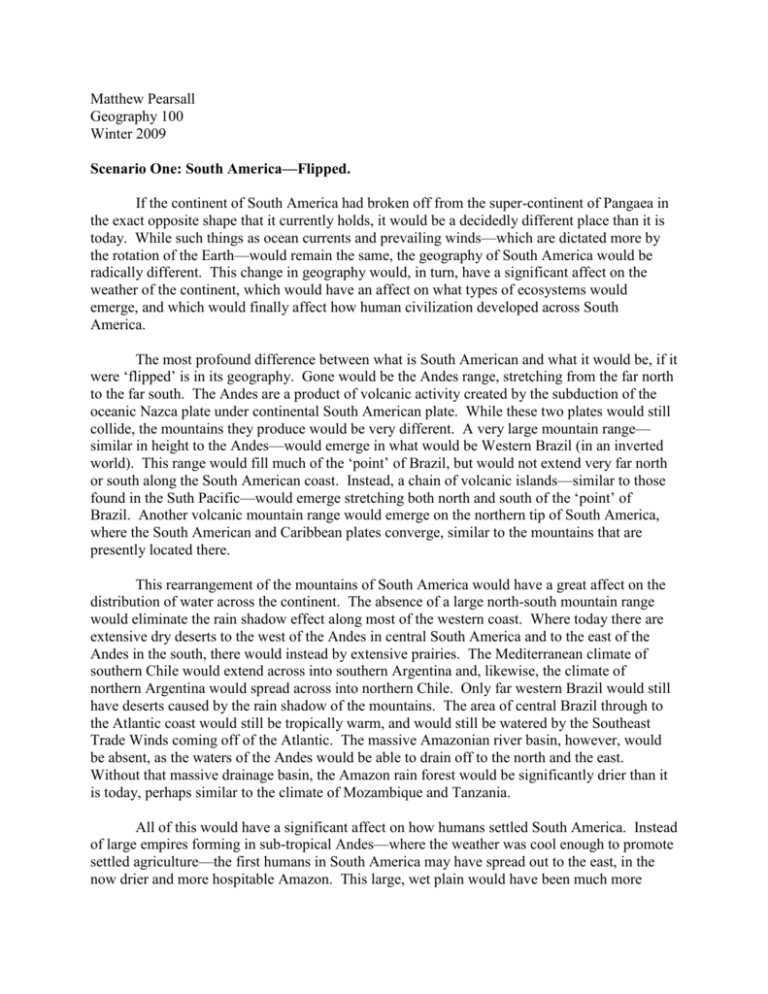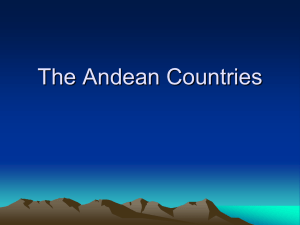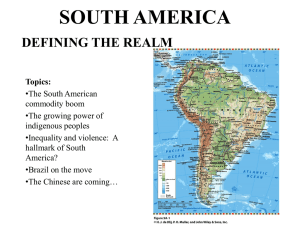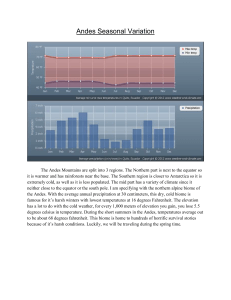Matthew_Pearsall09-A..
advertisement

Matthew Pearsall Geography 100 Winter 2009 Scenario One: South America—Flipped. If the continent of South America had broken off from the super-continent of Pangaea in the exact opposite shape that it currently holds, it would be a decidedly different place than it is today. While such things as ocean currents and prevailing winds—which are dictated more by the rotation of the Earth—would remain the same, the geography of South America would be radically different. This change in geography would, in turn, have a significant affect on the weather of the continent, which would have an affect on what types of ecosystems would emerge, and which would finally affect how human civilization developed across South America. The most profound difference between what is South American and what it would be, if it were ‘flipped’ is in its geography. Gone would be the Andes range, stretching from the far north to the far south. The Andes are a product of volcanic activity created by the subduction of the oceanic Nazca plate under continental South American plate. While these two plates would still collide, the mountains they produce would be very different. A very large mountain range— similar in height to the Andes—would emerge in what would be Western Brazil (in an inverted world). This range would fill much of the ‘point’ of Brazil, but would not extend very far north or south along the South American coast. Instead, a chain of volcanic islands—similar to those found in the Suth Pacific—would emerge stretching both north and south of the ‘point’ of Brazil. Another volcanic mountain range would emerge on the northern tip of South America, where the South American and Caribbean plates converge, similar to the mountains that are presently located there. This rearrangement of the mountains of South America would have a great affect on the distribution of water across the continent. The absence of a large north-south mountain range would eliminate the rain shadow effect along most of the western coast. Where today there are extensive dry deserts to the west of the Andes in central South America and to the east of the Andes in the south, there would instead by extensive prairies. The Mediterranean climate of southern Chile would extend across into southern Argentina and, likewise, the climate of northern Argentina would spread across into northern Chile. Only far western Brazil would still have deserts caused by the rain shadow of the mountains. The area of central Brazil through to the Atlantic coast would still be tropically warm, and would still be watered by the Southeast Trade Winds coming off of the Atlantic. The massive Amazonian river basin, however, would be absent, as the waters of the Andes would be able to drain off to the north and the east. Without that massive drainage basin, the Amazon rain forest would be significantly drier than it is today, perhaps similar to the climate of Mozambique and Tanzania. All of this would have a significant affect on how humans settled South America. Instead of large empires forming in sub-tropical Andes—where the weather was cool enough to promote settled agriculture—the first humans in South America may have spread out to the east, in the now drier and more hospitable Amazon. This large, wet plain would have been much more conducive to large-scale agriculture and irrigation; perhaps leading to the rise of major river empires such as those that rose up in Mesopotamia. Also, the Spanish conquest of South America would have taken a very different shape. The Spanish were mostly interested in South America's mineral wealth. In this scenario, much of that wealth is located in the off-shore island chains. Without the wealth of gold and silver, would the Spanish have bothered colonizing South America at all? For that matter, with the major empires of South America now oriented towards the East, might they have instead sailed across the Atlantic and colonized Spain, instead? Scenario Two: Arica, Chile. The waters of the Pacific Ocean off of Northern Chile are rich in marine life. Fishermen in the region around Arica produce a large portion of the anchovies consumed world-wide. Anchovies thrive in this region due to the presence of the Humbolt Current, which draws cool, nutrient rich water up from lower levels of the ocean. The nutrients in this water feed large quantities of phytoplankton, which in turn feed the large numbers of fish in the area. These fisheries, however, are vulnerable to changes in water temperature. Anchovies are a cool-water fish, and when water temperatures rise anchovy populations diminish. Unfortunately for the fishermen of Arica, the waters off the coast are periodically subject to El Nino. El Nino refers to a change in ocean currents which happens every few years wherein the flow of cool water diminishes—and sometimes even reverses—raising the temperature of the water. This change in temperature can have a devastating affect on fish populations, and consequently on the fishermen who depend on them. There is also reason to believe that other factors may be contributing to a further rise in the temperature of the waters off of Northern Chile. The area of the Southeast Pacific is covered by a huge sheet of stratocumulus clouds stretching almost 2,000 kilometers. These clouds shade the ocean from the sun and contribute to keeping the water temperatures cool. Aerosols in the atmosphere affect how these clouds form, and how water precipitates out of them. As the level of aerosols in the air increases due to human activity, they affect the formation of these clouds. All of this contributes to the unpredictability of the fish harvest for the citizens of Arica. What can they do to better weather the ups and downs of fish yields? The most obvious answer is for the local Aricans to diversify their economy, so that they will not be so heavily impacted by a bad fish harvest. Encouraging tourism may be an excellent source of revenue for the city. Arica is an old colonial port, with some fine old architecture present. Arica is also sandwiched between the Atacama Desert and some fine surf breaks on the Pacific coast. Between these three attractions there are many different types of tourists who could be brought into the region. Managed properly, tourism can bring in a large amount of income while having minimal impact on the local environment. Arica is also situated in a region of intense winds. The air currents of the Hadley Cell hit the Andes Mountains and rush northward. These winds are both strong and consistent, and may be an excellent source of wind-power generation for both Chile and Peru. There are many hurdles that would be involved in tapping the energy potential of the wind—including the necessity of a large capital investment upfront—but it could possibly be an opportunity to be on the leading edge of new ‘green’ technologies. Finally, the citizens of Arica could seek to diversify within the industries already present. This is the most prosaic approach, but perhaps the most affective. The Atacama Desert is a major mineral resource in Chile, and the ores extracted from there need to be shipped out by sea. Arica already serves as a mineral export port, but with investment in infrastructure Arica could make itself a more attractive port, drawing in more of the shipping business, and thereby diversify their economy. Finally, the fishermen of Arica could continue to fish as they always have, but explore fishing for other species when El Nino saps the anchovy population. Sardines are a warm water fish and, when El Nino causes the anchovy population to drop it also allows the sardine population to rise. By shifting from anchovy to sardine harvesting during periods of warmer water, the fishermen of Arica can continue in their own occupation without interruption.









